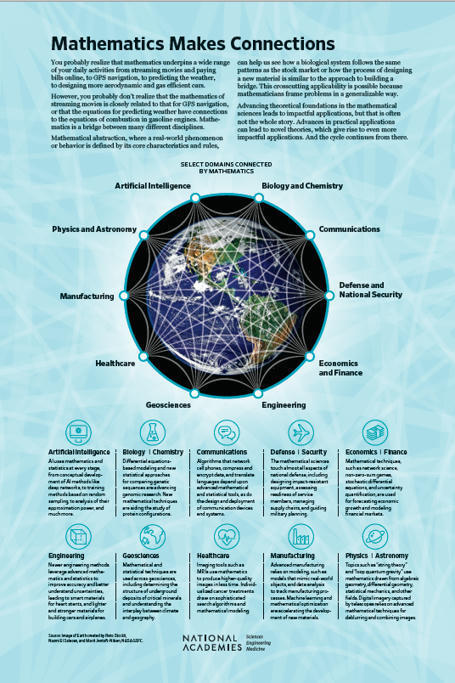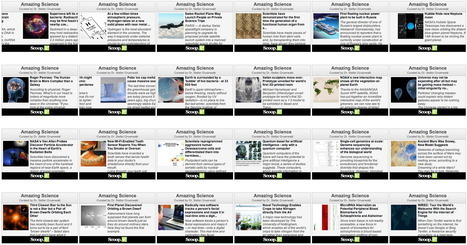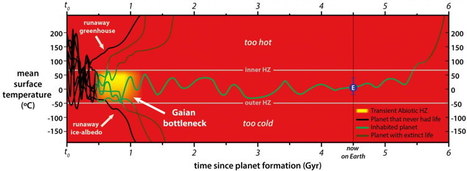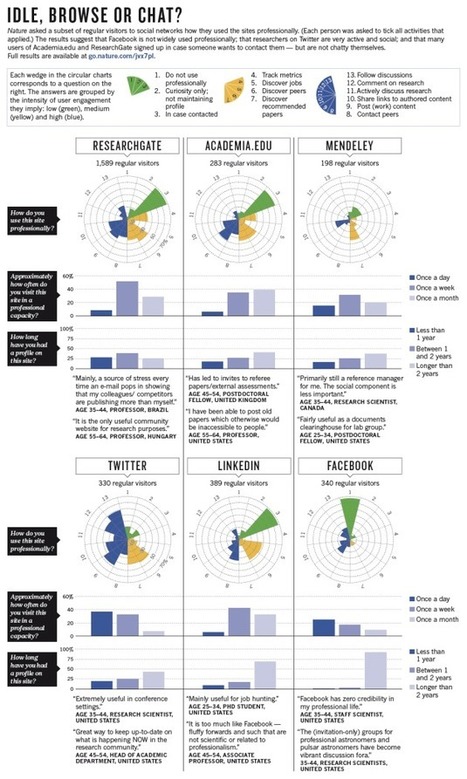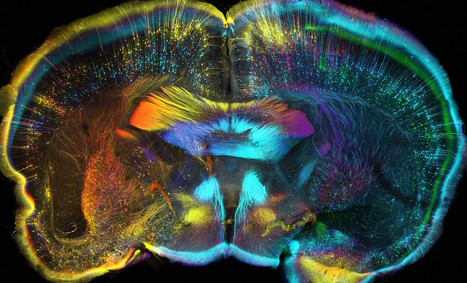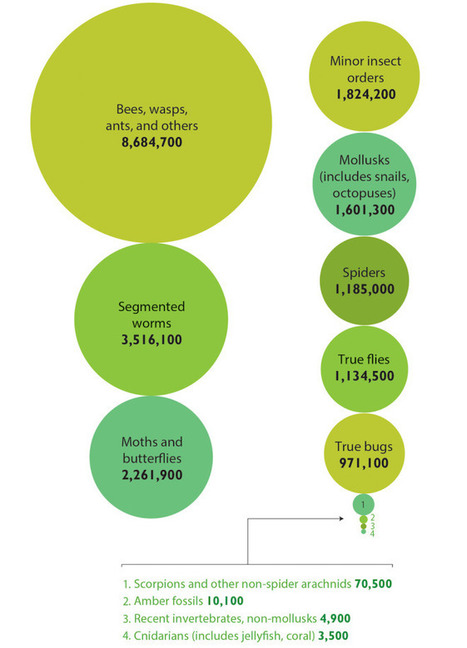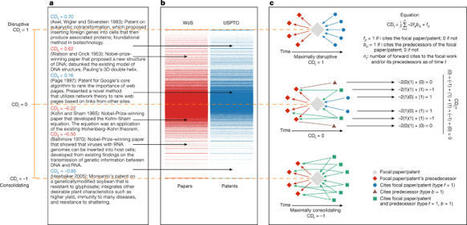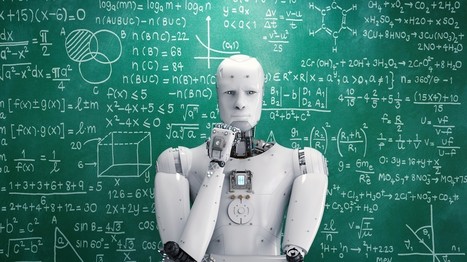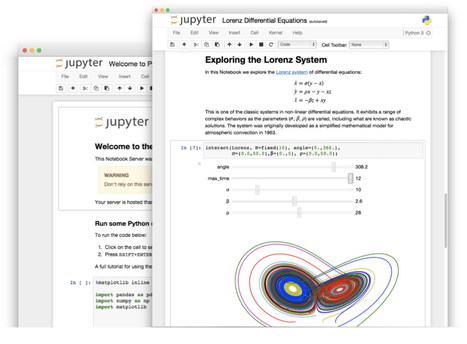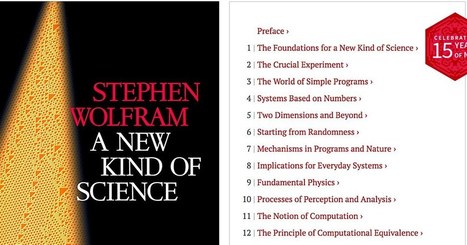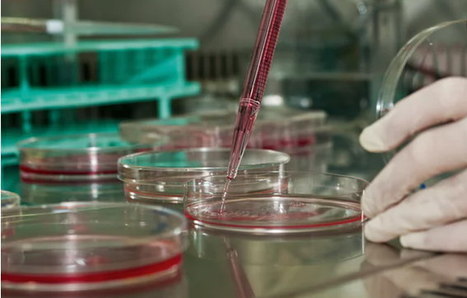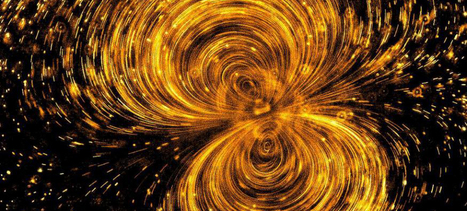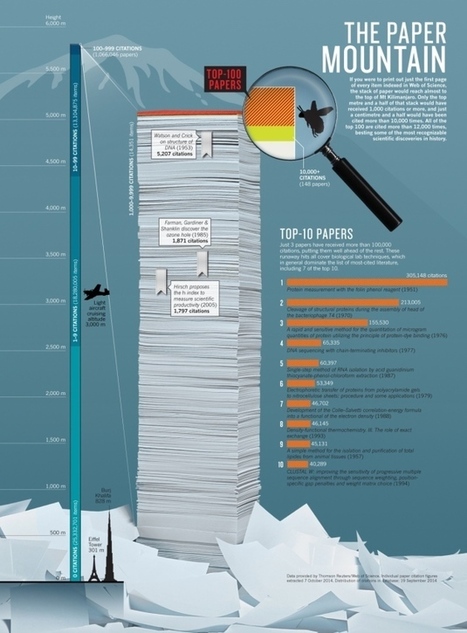 Your new post is loading...
Today’s mathematical research, both pure and applied, is paving the way for major scientific, engineering, and technological breakthroughs. Cutting-edge work in the mathematical sciences is responsible for advances in artificial intelligence, manufacturing, precision medicine, cybersecurity, and more. Find out how the mathematical sciences are helping to improve our everyday lives by checking out the stories and infographics below. This series of illustrations shows how advances in the mathematical sciences anticipate and enable later technologies that profoundly impact our daily lives, including life-saving advances in medical imaging and treatment, predictive traffic-avoiding routing, communications advances enabling GPS and high-speed cellular communications, safer online commerce with cryptographic security protocols, development of novel materials based on advanced simulations, improved forecasting of extreme weather events, and much more.
The leaps forward in technology have often built upon theoretical work whose impact would not have been predicted at the time of their creation. The same is true today: researchers and practitioners in the mathematical sciences continue to innovate, and we can only begin to imagine the future inventions their work will enable. Mathematical and statistical advances are playing a key role in emerging areas such as cyber warfare, quantum computing, artificial intelligence and machine learning for automation, genetic sequencing and related advances in vaccine creation to fight novel and existing viruses, and supply chain management.
The increasing pace of technological and social development will require many more advances in the mathematical sciences because they are a foundation for advances across science, medicine, business, finance, and even entertainment. New discoveries in mathematics happening today will reverberate for decades and centuries to come.
From the rapid development of vaccines for Covid-19 to the stunning collection of an asteroid sample, these were the biggest science moments of the year. Covid-19 dominated science coverage in 2020, and rightly so. The world grappled with how to combat the SARS-CoV-2 virus, learning about how it spread (whether it was on surfaces, via droplets or being airborne) and how it affected the human body (from immunity to symptoms like loss of smell.) But scientific endeavors in other fields, whether affected directly by the pandemic or indirectly by public health measures, didn’t come to a complete halt because of SARS-CoV-2. In incredible advances, researchers used three new tools for making discoveries about the sun, discovered that dinosaurs got cancer and published a study on a discovery in a Mexican cave that changes the timeline of humans’ arrival to the Americas. But none of those moments made this list of the biggest science stories of the year. It’s a subjective round-up, of course, but one compiled by our editors after much thought and debate. Presenting the key innovations, studies and discoveries that made 2020 an unforgettable year in science!
New planets found in distant corners of the galaxy. Climate models that improve our understanding of sea level rise. The emergence of new highly effective drugs. These scientific advances and discoveries have been in the news in recent months. While representing wildly divergent disciplines, from astronomy to biotechnology, they all have one thing in common: Artificial intelligence (AI) played a key role in their scientific discovery.
One of the more recent and famous examples came out of NASA at the end of 2017. The US space agency had announced an eighth planet discovered in the Kepler-90 system. Scientists had trained a neural network—a computer with a “brain” modeled on the human mind—to re-examine data from Kepler, a space-borne telescope with a four-year mission to seek out new life and new civilizations hidden in the vastness of space. Or, more precisely, to find habitable planets where life might just exist.
The researchers trained the artificial neural network on a set of 15,000 previously vetted signals until it could identify true planets and false positives 96 percent of the time. It then went to work on weaker signals from nearly 700 star systems with known planets.
The AI detected Kepler 90i—a hot, rocky planet that orbits its sun about every two Earth weeks—through a nearly imperceptible change in brightness captured when a planet passes a star. It also found a sixth Earth-sized planet in the Kepler-80 system.
What AI brings to science is being driven by three great advances in technology, according to Ross King from the Manchester Institute of Biotechnology at the University of Manchester, leader of a team that developed an artificially intelligent “scientist” called Eve. Those three advances include much faster computers, big datasets, and improved AI algorithms, King explained. “These advances increasingly give AI superhuman reasoning abilities.“
“AI systems can flawlessly remember vast numbers of facts and extract information effortlessly from millions of scientific papers, not to mention exhibit flawless logical reasoning and near-optimal probabilistic reasoning,“ King said.
AI systems also beat humans when it comes to dealing with huge, diverse amounts of data. That’s partly what attracted a team of glaciologists to turn to machine learning to untangle the factors involved in how heat from Earth’s interior might influence the ice sheet that blankets Greenland.
Algorithms juggling 22 geologic variables—such as bedrock topography, crustal thickness, magnetic anomalies, rock types, and proximity to features like trenches, ridges, young rifts, and volcanoes—are used to predict geothermal heat flux under the ice sheet throughout Greenland. The machine learning model, for example, predicts elevated heat flux upstream of Jakobshavn Glacier, the fastest-moving glacier in the world.
“The major advantage is that we can incorporate so many different types of data,” explains Leigh Stearns, associate professor of geology at Kansas University, whose research takes her to the polar regions to understand how and why Earth’s great ice sheets are changing, questions directly related to future sea level rise.
Your ultimate online portal to the future as well as looking up the past. Reporting on what's new and what's next in technology, science, gadgets, astronomy, physics, math, green tech and much more. We are aggregating science news from over 1,600 international news sources and select the best science news every day, 7 days a week, 24 hours per day. A ranking algorithm preselects the postings. Dubious non-peer reviewed science is filtered out. Amazing Science is the ultimate source to stay on top of the ever changing disciplines of science and get have a scientific resource to your disposal that is unprecedented.
Thomas Baruchel’s website shows images derived from complex analysis. John D. Cook used the ImageQuilts software by Edward Tufte and Adam Schwartz to create a large variety of scientific and artistic images.
Even those who follow science may be surprised by how quickly international collaboration in scientific studies is growing, according to new research. The number of multiple-author scientific papers with collaborators from more than one country more than doubled from 1990 to 2015, from 10 to 25 percent, one study found. And 58 more countries participated in international research in 2015 than did so in 1990. "Those are astonishing numbers," said Caroline Wagner, associate professor in the John Glenn College of Public Affairs at The Ohio State University, who helped conduct these studies. "In the 20th century, we had national systems for conducting research. In this century, we increasingly have a global system." Wagner presented her research Feb. 17 in Boston at the annual meeting of the American Association for the Advancement of Science. Even though Wagner has studied international collaboration in science for years, the way it has grown so quickly and widely has surprised even her. One unexpected finding was that international collaboration has grown in all fields she has studied. One would expect more cooperation in fields like physics, where expensive equipment (think supercolliders) encourages support from many countries. But in mathematics? "You would think that researchers in math wouldn't have a need to collaborate internationally - but I found they do work together, and at an increasing rate," Wagner said. "The methods of doing research don't determine patterns of collaboration. No matter how scientists do their work, they are collaborating more across borders." In a study published online last month in the journal Scientometrics, Wagner and two co-authors (who are both from The Netherlands) examined the growth in international collaboration in six fields: astrophysics, mathematical logic, polymer science, seismology, soil science and virology.
Via Mariaschnee
Lie on the beach this summer and your body will be bombarded by about sextillion photons of light per second. Most of these photons, or small packets of energy, originate from the Sun but a very small fraction have travelled across the Universe for billions of years before ending their existence when they collide with your skin. In a new study to be published in the Astrophysical Journal on August 12th, astronomers have accurately measured the light hitting Earth from outside our galaxy over a very broad wavelength range. The research looked at photons whose wavelengths vary from a fraction of a micron (damaging) to millimeters (harmless). But radiation from outside the galaxy constitutes only ten trillionths of your suntan, so there is no immediate need for alarm. International Centre for Radio Astronomy Research (ICRAR) astrophysicist Professor Simon Driver, who led the study, said we are constantly bombarded by about 10 billion photons per second from intergalactic space when we're outside, day and night. "Most of the photons of light hitting us originate from the Sun, whether directly, scattered by the sky, or reflected off dust in the Solar System," he said. "However, we're also bathed in radiation from beyond our galaxy, called the extra-galactic background light. These photons are minted in the cores of stars in distant galaxies, and from matter as it spirals into supermassive black holes." Professor Driver, who is based at the University of Western Australia, measured this ambient radiation from the Universe, from a wide range of wavelengths by combining deep images from a flotilla of space telescopes. He and collaborators from Arizona State University and Cardiff University collated observations from NASA's Galaxy Evolution Explorer and Wide-field Infrared Survey Explorer telescopes, the Spitzer and Hubble space telescopes, the European Space Agency's Herschel space observatory and Australia's Galaxy And Mass Assembly survey to make the most accurate measurements ever of the extra-galactic background light. While 10 billion photons a second might sound like a lot, Professor Driver said we would have to bask in it for trillions of years before it caused any long-lasting damage. Professor Rogier Windhorst, from Arizona State University, said the Universe also comes with its own inbuilt protection as about half the energy coming from the ultraviolet light of galaxies is converted into a less damaging wavelength by dust grains. "The galaxies themselves provide us with a natural suntan lotion with an SPF of about two," he said.
The Earth is not the only planet in our galaxy with liquid water on its surface and energy sources and nutrients to enable life to form. Although the universe is filled with stars and planets conducive to life, the absence of any evidence for alien life suggests that even if the emergence of life is easy, its persistence may be difficult. Recehnt work challenges conventional views that physics-based habitable zones provide stable conditions for life for many billions of years. Although, the cottage industry of habitable zone modellers can turn various knobs that control atmospheric and geophysical properties to stabilise planets over short-timescales, they have mostly ignored the role of biology in keeping planets habitable over billions of years. This is in part because the complexities of interactions between microbial communities that keep ecosystems stable are not sufficiently understood. Scientists now hypothesize that even if life does emerge on a planet, it rarely evolves quickly enough to regulate greenhouse gases, and thereby keep surface temperatures compatible with liquid water and habitability.
Giant academic social networks have taken off to a degree that no one expected even a few years ago. A Nature survey explores why.
Via Neelima Sinha
Experiments in evolution are exploring what would happen if we rewound the tape of life.
Via Complexity Digest
Most wouldn't go looking for magnified cat tongues, sheep stomachs, or parasitoid wasps in a search for gorgeous imagery. But as the finalists for the 2015 Wellcome Image Awards show, these things can be breathtakingly beautiful.
The award showcases the best in science images for the year. "The breath-taking riches of the imagery that science generates are so important in telling stories about research and helping us to understand often abstract concepts," British geneticist, author, and broadcaster Adam Rutherford, one of this year's judges, said in a statement.
"It's not just about imaging the very small either, it's about understanding life, death, sex and disease: the cornerstones of drama and art. Once again, the Wellcome Image Awards celebrate all of this and more with this year’s incredible range of winning images," Rutherford said.
The images are part of the Wellcome Images collections, which are free for non-commercial use and intended to help illustrate scientific concepts and findings.
The winner will be announced at an awards ceremony on March 18. To see previous year's winners, check out Wellcome's Web site. The 20 finalists for 2015 will be showcased at 11 science centers around Britain. Fans of beauty and science in the United States are in luck, too: MIT's Koch Institute and The University of Texas Medical Branch at Galveston will also show off the winners sometime in March.
The American Museum of Natural History has a great new video series: Shelf Life. It features the 33,430,000 artifacts and specimens estimated to be in the museum. From their description:
“Shelf Life is a collection for curious minds—opening doors, pulling out drawers, and taking the lids off some of the incredible, rarely-seen items in the American Museum of Natural History. Over the next year, Shelf Life will explore topics like specimen preparation, learn why variety is vital, and meet some of the people who work in the Museum collections.”
A lot of natural history museums are trying to make the invisible visible by turning to video and social media. The vast majority of a museum’s collection is never seen by anyone besides a tiny group of experts. How do you convince the public that they should care about a bunch of dead stuff? The perception of a lot of people is that museums are about naming and pickling things. Travel to exotic places, find unusual species, and kill them.
This assumes that things are just warehoused in a museum, which is certainly true in one sense. Museums are a long term, stable library of our past and our present. But a library that stops acquiring and indexing books isn’t going to remain relevant.
What’s actually stored in a museum is change that you can touch and measure. TheCDC is using museum specimens to track human pathogens and diseases over space and time. Ecologists are looking at Hawaiian birds collected and preserved 100 years ago (now extinct) to see if they can find a way to protect today’s Galapagos species from canarypox. Preserved insects helped us figure out dinosaurs didn’t have lice via advanced molecular techniques.
The video series also makes some of the work that goes into maintaining a collection visible. You can’t just put something in a jar and walk away; constant maintenance and care helps to make sure that we can still see insects collected by Darwin, or plants from Linnaeus’ cabinet.
How do you build a universal quantum computer? Turns out, this question was addressed by theoretical physicists about 15 years ago. The answer was laid out in a research paper and has become known as the DiVincenzo criteria. The prescription is pretty clear at a glance; yet in practice the physical implementation of a full-scale universal quantum computer remains an extraordinary challenge.
To glimpse the difficulty of this task, consider the guts of a would-be quantum computer. The computational heart is composed of multiple quantum bits, or qubits, that can each store 0 and 1 at the same time. The qubits can become “entangled,” or correlated in ways that are impossible in conventional devices. A quantum computing device must create and maintain these quantum connections in order to have a speed and storage advantage over any conventional computer. That’s the upside. The difficulty arises because harnessing entanglement for computation only works when the qubits are almost completely isolated from the outside world. Isolation and control becomes much more difficult as more and more qubits are added into the computer. Basically, as quantum systems are made bigger, they generally lose their quantum-ness.
In pursuit of a quantum computer, scientists have gained amazing control over various quantum systems. One leading platform in this broad field of research is trapped atomic ions, where nearly 20 qubits have been juxtaposed in a single quantum register. However, scaling this or any other type of qubit to much larger numbers while still contained in a single register will become increasingly difficult, as the connections will become too numerous to be reliable.
Physicists led by ion-trapper Christopher Monroe at the JQI have now proposed a modular quantum computer architecture that promises scalability to much larger numbers of qubits. This research is described in the journal Physical Review A (reference below), a topical journal of the American Physical Society. The components of this architecture have individually been tested and are available, making it a promising approach. In the paper, the authors present expected performance and scaling calculations, demonstrating that their architecture is not only viable, but in some ways, preferable when compared to related schemes. Individual qubit modules are at the computational center of this design, each one consisting of a small crystal of perhaps 10-100 trapped ions confined with electromagnetic fields. Qubits are stored in each atomic ion’s internal energy levels. Logical gates can be performed locally within a single module, and two or more ions can be entangled using the collective properties of the ions in a module.
One or more qubits from the ion trap modules are then networked through a second layer of optical fiber photonic interconnects. This higher-level layer hybridizes photonic and ion-trap technology, where the quantum state of the ion qubits is linked to that of the photons that the ions themselves emit. Photonics is a natural choice as an information bus as it is proven technology and already used for conventional information flow. In this design, the fibers are directed to a reconfigurable switch, so that any set of modules could be connected.
The switch system, which incorporates special micro-electromechanical mirrors (MEMs) to direct light into different fiber ports, would allow for entanglement between arbitrary modules and on-demand distribution of quantum information.
Via Szabolcs Kósa
|
https://twitter.com/ItaiYanai/status/1610706449675747328
Smart summary:
A new Nature paper provides evidence that science has become less innovative since the 1950s, and suggests reversing the trend by reading widely, focusing on research quality over quantity, and taking year-long sabbaticals. The authors also suggest that to increase our innovative thinking, we need to allow time for the creative process by using analogies, finding new questions, embracing contradictions, importing/exporting ideas, improvising, and exploring data.
-------
New Nature paper provides evidence that science has become less innovative since the 1950s. The authors suggest reversing the trend by:
1. reading widely,
2. focusing less on quantity of papers, & more on research quality,
3. taking year-long sabbaticals.
https://t.co/oYV5JCXRl8
Using just the language in millions of old scientific papers, a machine learning algorithm was able to make completely new scientific discoveries. In a study published in Nature on July 3, 2019, researchers from the Lawrence Berkeley National Laboratory used an algorithm called Word2Vec sift through scientific papers for connections humans had missed. Their algorithm then spit out predictions for possible thermoelectric materials, which convert heat to energy and are used in many heating and cooling applications. The algorithm didn’t know the definition of thermoelectric, though. It received no training in materials science. Using only word associations, the algorithm was able to provide candidates for future thermoelectric materials, some of which may be better than those we currently use. “It can read any paper on material science, so can make connections that no scientists could,” researcher Anubhav Jain said. “Sometimes it does what a researcher would do; other times it makes these cross-discipline associations.” To train the algorithm, the researchers assessed the language in 3.3 million abstracts related to material science, ending up with a vocabulary of about 500,000 words. They fed the abstracts to Word2vec, which used machine learning to analyze relationships between words. “The way that this Word2vec algorithm works is that you train a neural network model to remove each word and predict what the words next to it will be,” Jain said. “By training a neural network on a word, you get representations of words that can actually confer knowledge.” Using just the words found in scientific abstracts, the algorithm was able to understand concepts such as the periodic table and the chemical structure of molecules. The algorithm linked words that were found close together, creating vectors of related words that helped define concepts. In some cases, words were linked to thermoelectric concepts but had never been written about as thermoelectric in any abstract they surveyed. This gap in knowledge is hard to catch with a human eye, but easy for an algorithm to spot. After showing its capacity to predict future materials, researchers took their work back in time, virtually. They scrapped recent data and tested the algorithm on old papers, seeing if it could predict scientific discoveries before they happened. Once again, the algorithm worked. In one experiment, researchers analyzed only papers published before 2009 and were able to predict one of the best modern-day thermoelectric materials four years before it was discovered in 2012. This new application of machine learning goes beyond materials science. Because it’s not trained on a specific scientific dataset, you could easily apply it to other disciplines, retraining it on literature of whatever subject you wanted. Vahe Tshitoyan, the lead author on the study, says other researchers have already reached out, wanting to learn more. “This algorithm is unsupervised and it builds its own connections,” Tshitoyan said. “You could use this for things like medical research or drug discovery. The information is out there. We just haven’t made these connections yet because you can’t read every article.”
An improved architecture and enthusiastic user base are driving uptake of the open-source web tool. Perched atop the Cerro Pachón ridge in the Chilean Andes is a building site that will eventually become the Large Synoptic Survey Telescope (LSST). When it comes online in 2022, the telescope will generate terabytes of data each night as it surveys the southern skies automatically. And to crunch those data, astronomers will use a familiar and increasingly popular tool: the Jupyter notebook. Jupyter is a free, open-source, interactive web tool known as a computational notebook, which researchers can use to combine software code, computational output, explanatory text and multimedia resources in a single document. Computational notebooks have been around for decades, but Jupyter in particular has exploded in popularity over the past couple of years. This rapid uptake has been aided by an enthusiastic community of user–developers and a redesigned architecture that allows the notebook to speak dozens of programming languages — a fact reflected in its name, which was inspired, according to co-founder Fernando Pérez, by the programming languages Julia (Ju), Python (Py) and R. One analysis of the code-sharing site GitHub counted more than 2.5 million public Jupyter notebooks in September 2018, up from 200,000 or so in 2015. In part, says Pérez, that growth is due to improvements in the web software that drives applications such as Gmail and Google Docs; the maturation of scientific Python and data science; and, especially, the ease with which notebooks facilitate access to remote data that might otherwise be impractical to download — such as from the LSST. “In many cases, it’s much easier to move the computer to the data than the data to the computer,” says Pérez of Jupyter’s cloud-based capabilities. “What this architecture helps to do is to say, you tell me where your data is, and I’ll give you a computer right there.” For data scientists, Jupyter has emerged as a de facto standard, says Lorena Barba, a mechanical and aeronautical engineer at George Washington University in Washington DC. Mario Jurić, an astronomer at the University of Washington in Seattle who coordinates the LSST’s data-management team, says: “I’ve never seen any migration this fast. It’s just amazing.” Computational notebooks are essentially laboratory notebooks for scientific computing. Instead of pasting, say, DNA gels alongside lab protocols, researchers embed code, data and text to document their computational methods. The result, says Jupyter co-creator Brian Granger at California Polytechnic State University in San Luis Obispo, is a “computational narrative” — a document that allows researchers to supplement their code and data with analysis, hypotheses and conjecture. For data scientists, that format can drive exploration. Notebooks, Barba says, are a form of interactive computing, an environment in which users execute code, see what happens, modify and repeat in a kind of iterative conversation between researcher and data. They aren’t the only forum for such conversations — IPython, the interactive Python interpreter on which Jupyter’s predecessor, IPython Notebook, was built, is another. But notebooks allow users to document those conversations, building “more powerful connections between topics, theories, data and results”, Barba says. Researchers can also use notebooks to create tutorials or interactive manuals for their software. This is what Mackenzie Mathis, a systems neuroscientist at Harvard University in Cambridge, Massachusetts, did for DeepLabCut, a programming library her team developed for behavioural-neuroscience research. And they can use notebooks to prepare manuscripts, or as teaching aids. Barba, who has implemented notebooks in every course she has taught since 2013, related at a keynote address in 2014 that notebooks allow her students to interactively engage with — and absorb material from — lessons in a way that lectures cannot match. “IPython notebooks are really a killer app for teaching computing in science and engineering,” she said. The Jupyter notebook has two components. Users input programming code or text in rectangular cells in a front-end web page. The browser then passes that code to a back-end ‘kernel’, which runs the code and returns the results (see our example at go.nature.com/2yqq7ak). By Pérez’s count, more than 100 Jupyter kernels have been created, supporting dozens of programming languages. Normally, each notebook can run only one kernel and one language, but workarounds exist. One demo notebook, for instance, speaks Python, Julia, R and Fortran. Importantly, the kernels need not reside on the user’s computer. When future users of the LSST use Jupyter notebooks to analyse their data, the code will be running on a supercomputer in Illinois, providing computational muscle no desktop PC could match. Notebooks can also run in the cloud. Google’s Colaboratory project, for instance, provides a Google-themed front-end to the Jupyter notebook. It enables users to collaborate and run code that exploits Google’s cloud resources — such as graphical processing units — and to save their documents on Google Drive. Jupyter’s newest variant is JupyterLab, which launched as a beta in January 2018 and is available (like the Jupyter notebook) either as a stand-alone package or as part of the free Anaconda scientific-computing environment. Jason Grout is a software engineer at the financial-services company Bloomberg in San Francisco, California, and a member of the JupyterLab team. He calls JupyterLab a “next-generation web interface” for the Jupyter notebook — one that extends the familiar notebook metaphor with drag-and-drop functionality, as well as file browsers, data viewers, text editors and a command console. Whereas the standard Jupyter notebook assigns each notebook its own kernel, JupyterLab creates a computing environment that allows these components to be shared. Thus, a user could view a notebook in one window, edit a required data file in another, and log all executed commands in a third — all within a single web-browser interface. Users can also customize JupyterLab to fit their workflow. Built-in viewers exist for image, text and CSV files, for instance, but users can build custom components as well. These could display things such as genomic alignments or geospatial data. An attendee on a course taught by Pérez even created a component to display 3D brain-imaging data. “This is a completely [neuroscience] domain-specific tool, obviously — the Jupyter team has no business writing these things. But we provide the right standards, and then that community in 24 hours can come back and write one,” he says.
Via THE OFFICIAL ANDREASCY
Stephen Wolfram looks back at his bold take on the computational universe.
In the mathematical field of dynamical systems, an attractor is a set of numerical values toward which a system tends to evolve, for a wide variety of starting conditions of the system.[1] System values that get close enough to the attractor values remain close even if slightly disturbed. An attractor is called strange if it has a fractal structure.[1] This is often the case when the dynamics on it are chaotic, but strange nonchaotic attractors also exist. If a strange attractor is chaotic, exhibiting sensitive dependence on initial conditions, then any two arbitrarily close alternative initial points on the attractor, after any of various numbers of iterations, will lead to points that are arbitrarily far apart (subject to the confines of the attractor), and after any of various other numbers of iterations will lead to points that are arbitrarily close together. Thus a dynamic system with a chaotic attractor is locally unstable yet globally stable: once some sequences have entered the attractor, nearby points diverge from one another but never depart from the attractor.[5] The term strange attractor was coined by David Ruelle and Floris Takens to describe the attractor resulting from a series of bifurcations of a system describing fluid flow.[6] Strange attractors are often differentiable in a few directions, but some are like a Cantor dust, and therefore not differentiable. Strange attractors may also be found in presence of noise, where they may be shown to support invariant random probability measures of Sinai–Ruelle–Bowen type.[7] Examples of strange attractors include the double-scroll attractor, Hénon attractor, Rössler attractor, Tamari attractor, and the Lorenz attractor.
If scientists had sacred objects, this would be one of them: a single, closely guarded 137-year-old cylinder of metal, housed in a vault outside of Paris. It is a prototype that precisely defines a kilogram of mass everywhere in the universe. A kilogram of ground beef at the grocery store has the same mass as this one special hunk of metal, an alloy of platinum and iridium. A 60-kilogram woman has a mass 60 times as much. Even far-flung astronomical objects such as comets are measured relative to this all-important cylinder: Comet 67P/Churyumov–Gerasimenko, which was recently visited by the European Space Agency’s Rosetta spacecraft (SN: 2/21/15, p. 6), has a mass of about 10 trillion such cylinders. But there’s nothing special about that piece of metal, and its mass isn’t even perfectly constant — scratches or gunk collecting on its surface could change its size subtly (SN: 11/20/10, p. 12). And then a kilogram of beef would be slightly more or less meat than it was before. That difference would be too small to matter when flipping burgers, but for precise scientific measurements, a tiny shift in the definition of the kilogram could cause big problems. That issue nags at some researchers. They would prefer to define important units — including kilograms, meters and seconds — using immutable properties of nature, rather than arbitrary lengths, masses and other quantities dreamed up by scientists. If humans were to make contact with aliens and compare systems of units, says physicist Stephan Schlamminger, “we’d be the laughingstock of the galaxy.” To set things right, metrologists — a rare breed of scientist obsessed with precise measurements — are revamping the system. Soon, they will use fundamental constants of nature — unchanging numbers such as the speed of light, the charge of an electron and the quantum mechanical Planck constant — to calibrate their rulers, scales and thermometers. They’ve already gotten rid of an artificial standard that used to define the meter — an engraved platinum-iridium bar. In 2018, they plan to jettison the Parisian kilogram cylinder, too.
Via Kim Frye
Since major gun law reforms were introduced in Australia, mass shootings have not only stopped, but there has also been an accelerating reduction in rates of firearm-related homicide and suicides, a landmark study has found. It has been two decades since rapid-fire long guns were banned in Australia, including those already in private ownership, and 19 years since the mandatory buyback of prohibited firearms by government at market price was introduced. A handgun buyback program was later introduced, in 2003. Researchers from the University of Sydney and Macquarie University analysed data on intentional suicide and homicide deaths caused by firearms from the National Injury Surveillance Unit, and intentional firearm death rates from the Australian Bureau of Statistics. For the period after the 1996 reforms, rates of total homicides and suicides from all causes were also examined to consider whether people may have substituted guns for alternative means. From 1979 to 1996, the average annual rate of total non-firearm suicide and homicide deaths was rising at 2.1% per year. Since then, the average annual rate of total non-firearm suicide and homicide deaths has been declining by 1.4%, with the researchers concluding there was no evidence of murderers moving to other methods, and that the same was true for suicide. The average decline in total firearm deaths accelerated significantly, from a 3% decline annually before the reforms to a 5% decline afterwards, the study found. In the 18 years to 1996, Australia experienced 13 fatal mass shootings in which 104 victims were killed and at least another 52 were wounded. There have been no fatal mass shootings since that time, with the study defining a mass shooting as having at least five victims. The findings were published in the Journal of the American Medical Association on Thursday, days after the US Senate rejected a string of Republican and Democrat measures to restrict guns. The reforms were proposed in response to the deadliest mass shooting in US history, at an LGBTI nightclub in Orlando. The 1996 reforms introduced in Australia came just months after a mass shooting known as the Port Arthur massacre, when Martin Bryant used two semi-automatic rifles to kill 35 people and wound 23 others in Port Arthur, Tasmania. The reforms had the support of all major political parties.
All publicly funded scientific papers published in Europe could be made free to access by 2020, under a “life-changing” reform ordered by the European Union’s science chief, Carlos Moedas. The Competitiveness Council, a gathering of ministers of science, innovation, trade and industry, agreed on the target following a two-day meeting in Brussels last week. The move means publications of the results of research supported by public and public-private funds would be freely available to and reusable by anyone. It could affect the paid-for subscription model used by many scientific journals, and undermine the common practice of releasing reports under embargo. At present the results of some publicly funded research are not accessible to people outside universities and similar institutions without one-off payments, which means that many teachers, doctors, entrepreneurs and others do not have access to the latest scientific insights. In the UK, funding bodies generally require that researchers publish under open access terms, with open access publishing fees paid from the researcher’s grant. The council said this data must be made accessible unless there were well-founded reasons for not doing so, such as intellectual property rights or security or privacy issues. The changes are part of a broader set of recommendations in support of Open Science, a concept that also includes improved storage of and access to research data, Science magazine reports. Open Science has been heavily lobbied for by the Dutch government, which currently holds the presidency of the Council of the EU, as well as by Moedas, the European commissioner for research and innovation. Moedas told a press conference: “We probably don’t realize it yet, but what the Dutch presidency has achieved is unique and huge. The commission is totally committed to help move this forward.”
An image of a gold chip that traps ions for use in quantum computing has come first in EPSRC's third science photography competition. ‘Microwave ion-trap chip for quantum computation’, by Diana Prado Lopes Aude Craik and Norbert Linke, from the University of Oxford, shows the chip’s gold wire-bonds connected to electrodes which transmit electric fields to trap single atomic ions a mere 100 microns above the device’s surface. The image, taken through a microscope in one of the university's cleanrooms, came first in the Eureka category as well as winning overall against many other stunning pictures, featuring research in action, in the EPSRC competition – now in its third year. Doctoral student Diana Prado Lopes Aude Craik, explained how the chip works: “When electric potentials are applied to the chip’s gold electrodes, single atomic ions can be trapped. These ions are used as quantum bits (‘qubits’), units which store and process information in a quantum computer. Two energy states of the ions act as the ‘0’ and ‘1’ states of these qubits. Slotted electrodes on the chip deliver microwave radiation to the ions, allowing us to manipulate the stored quantum information by exciting transitions between the ‘0’ and ‘1’ energy states. “This device was micro-fabricated using photolithography, a technique similar to photographic film development. Gold wire-bonds connect the electrodes to pads around the device through which signals can be applied. You can see the wire-bonding needle in the top-left corner of the image. The Oxford team recently achieved the world’s highest-performing qubits and quantum logic operations.” The development of the ion-trap chip was funded jointly by the EPSRC and the US Army Research Office. The competition’s five categories were: Eureka, Equipment, People, Innovation, and Weird and Wonderful. Winning images feature: - A spectacular 9.5 meter wave created to wow crowds at the FloWave Ocean Energy Research Facility at the University of Edinburgh
- An iCub humanoid robot learning about how to play from a baby as part of robotics research taking place at Aberystwyth University
- The intense, blinding light of plasma formed by an ultrafast laser being used to process glass at the EPSRC Centre for Innovative Manufacturing in Ultra Precision at the University of Cambridge
- A beautiful rotating jet of viscoelastic liquid water resembling a spinning dancer that demonstrates the effect of adding a tiny amount of polymer to water and an example of fluid dynamics research at Imperial College London
One of the judges was Professor Robert Winston, he said: “This competition helps us engage with academics and these stunning images are a great way to connect the general public with research they fund, and inspire everyone to take an interest in science and engineering.”
Gun deaths are a serious public health issue in the United States and the scope of the problem is often difficult to illustrate. A new study published in The American Journal of Medicine lays out the risk in concrete terms. When compared to 22 other high-income nations, Americans are ten times more likely to be killed by a gun than their counterparts in the developed world. Specifically, gun homicide rates are 25 times higher in the U.S. and, while the overall suicide rate is on par with other high-income nations, the U.S. gun suicide rate is eight times higher.
In order to help put America's relationship with guns into perspective, researchers from the University of Nevada-Reno and the Harvard T.H. Chan School of Public Health analyzed mortality data gathered by the World Health Organization in 2010. Investigators found that despite having similar rates of nonlethal crimes as other high-income countries, the U.S. has much higher rates of lethal violence, mostly driven by extremely higher rates of gun-related homicides.
The study reveals some stark truths about living and dying in the United States. When compared to other high-income nations, as an American you are: • Seven times more likely to be violently killed • Twenty-five times more likely to be violently killed with a gun • Six times more likely to be accidentally killed with a gun • Eight times more likely to commit suicide using a gun • Ten times more likely to die from a firearm death overall
Homicide is the second leading cause of death for Americans 15 to 24 years of age, and the third leading cause of death among those 25 to 34 years of age. Investigators found that for these two groups, the risk relative to their counterparts in other developed nations is alarmingly elevated. Americans 15 to 24 years of age are 49 times more likely to die from firearm homicide compared to similarly aged young people in other high-income nations. For those aged 25 to 34, the risk is 32 times higher.
You're probably aware that heart disease and cancer are far and away the leading causes of death in America. But globally the picture is more complicated: The above map shows the leading cause of lost years of life by country (click to see a larger version). The data comes from the Global Burden of Disease study, whose 2013 installment was released just a few weeks ago. It's worth stressing that "cause of lost years of life" and "cause of death" aren't identical. For example, deaths from preterm births may cause more lost years of life in a country than deaths from heart disease even if heart disease is the leading cause of death. Deaths from preterm births amount to many decades of lost life, whereas heart disease tends to develop much later on.
But that makes the fact that heart disease is the leading cause of lost life in so many countries all the more striking, and indicative of those countries' successes in reducing childhood mortality. By contrast, in many lower-income countries, the leading cause is something like malaria, diarrhea, preterm birth, HIV/AIDS, or violence, which all typically afflict people earlier in life than heart disease or stroke. We've made considerable progress in fighting childhood mortality across the globe in recent decades, but there's still much work left to be done.
The discovery of high-temperature superconductors, the determination of DNA’s double-helix structure, the first observations that the expansion of the Universe is accelerating — all of these breakthroughs won Nobel prizes and international acclaim. Yet none of the papers that announced them comes anywhere close to ranking among the 100 most highly cited papers of all time.
Citations, in which one paper refers to earlier works, are the standard means by which authors acknowledge the source of their methods, ideas and findings, and are often used as a rough measure of a paper’s importance. Fifty years ago, Eugene Garfield published the Science Citation Index (SCI), the first systematic effort to track citations in the scientific literature. To mark the anniversary, Nature asked Thomson Reuters, which now owns the SCI, to list the 100 most highly cited papers of all time. (See the full list at Web of Science Top 100.xls or the interactive graphic, below.) The search covered all of Thomson Reuter’s Web of Science, an online version of the SCI that also includes databases covering the social sciences, arts and humanities, conference proceedings and some books. It lists papers published from 1900 to the present day.
The exercise revealed some surprises, not least that it takes a staggering 12,119 citations to rank in the top 100 — and that many of the world’s most famous papers do not make the cut. A few that do, such as the first observation1 of carbon nanotubes (number 36) are indeed classic discoveries. But the vast majority describe experimental methods or software that have become essential in their fields.
The most cited work in history, for example, is a 1951 paper2 describing an assay to determine the amount of protein in a solution. It has now gathered more than 305,000 citations — a recognition that always puzzled its lead author, the late US biochemist Oliver Lowry.
|



 Your new post is loading...
Your new post is loading...

